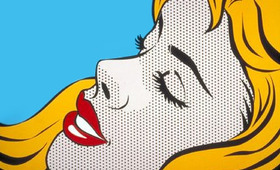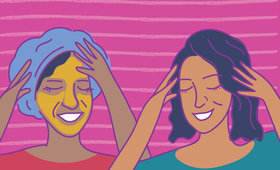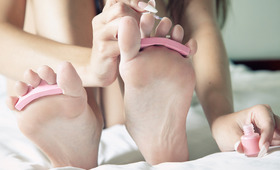We often base our skincare routine on our skin type (think: oily, dry, sensitive) or specific skin concerns—like dullness or hyperpigmentation—but there’s another factor that can help inform our skincare regime. Enter: the Fitzpatrick Scale.
Thomas B. Fitzpatrick created the classification in 1972 as a way to categorize the spectrum of skin tones based on the skin’s tendency to burn or tan. It takes into account our skin’s response to UV light plus race, ethnicity, skin, hair, and eye colors—all of which affect our risk of photoaging, laser treatments, and skin cancer, to name a few.

Fitzpatrick skin type I
Skin type I always burns in the sun and never tans. Folks with this skin type typically have very light skin, blonde hair, blue or green eyes, and maybe some freckles. They’re more prone to experiencing signs of aging, fine lines, wrinkles, and redness.
Fitzpatrick skin type II
Skin type II burns easily and sometimes tans (after the sunburn fades). People with this skin type tend to have fair skin, blonde hair, green or blue eyes, and maybe some freckles. They can easily experience wrinkles, sunspots, and redness.
Fitzpatrick skin type III
Skin type III tans easily but may get mild sunburns, depending on the intensity of the sun exposure. If you’re in this category, you likely have light to medium skin, blonde or brown hair, and blue or brown eyes. This category can easily experience sun damage and skin aging from sun exposure.
Fitzpatrick skin type IV
Skin type IV tans easily and rarely burns. People with this skin type tend to have light brown or olive skin, brown hair, and brown eyes. They rarely freckle but can easily experience hyperpigmentation.
Fitzpatrick skin type V
Skin type V rarely burns, but tans very easily. Folks in this category tend to have brown skin, brown eyes, and dark hair. They never freckle but can often experience hyperpigmentation.
Fitzpatrick skin type VI
Skin type VI never burns, but tans very easily. If you’re in this category, you likely have dark brown skin and dark brown to black hair and eyes. This category experiences deeper hyperpigmentation very easily.
While the Fitzpatrick Scale doesn’t offer a comprehensive view of your skin type or concern, it can help inform risks, conditions, and reactions our skin is more prone to, allowing you to build a proactive skincare routine. The scale can also help inform which lasers and skin treatments are suitable for your skin type to help mitigate any adverse reactions.
Generally speaking, skin types on the lower end of the scale are more prone to fine lines, wrinkles, redness, and sunspots. On the other hand, skin tones on the higher end of the scale have more melanin, providing more protection against UV radiation and fewer signs of aging. However, they’re more likely to experience hyperpigmentation, scars, and laser burns. Regardless of your skin type, we recommend routine yearly skin cancer screenings.
You Might Also Like
-

DIY Skin Care
DIY Pore Strips
- 1673
-

Products
TSA-Approved Beauty Products
- 587
-

Tips & Tricks
From Kitchen Counter to Beauty Cabinet: DIY Beauty Tips from Mom
- 80
-

Tips & Tricks
Beautylish's Travel Beauty Tips
- 290
-

From the Archive
Pamper Your Own Feet
- 1525
-

Interviews
Oscar Beauty Chat with Celebrity Makeup Artist Matthew Vanleeuwen
- 19







